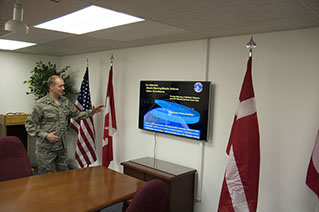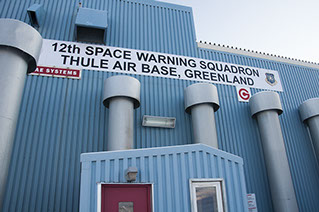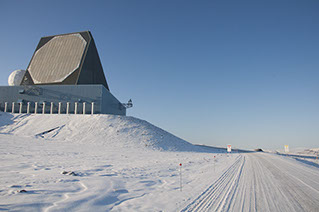By Patrick Dickson
Stars and Stripes
THULE AIR BASE, Greenland — In the dimly lit Missile Warning Operations Center, scrubbed of classified information before visitors enter, two airmen monitored the computer screens, watching for the telltale indicators of ballistic missile launches.
They talked over a secure system with other operators around the globe, never more than an arm’s length from a telephone with push-button connections to some of the highest-level security personnel in the United States.
The airmen were at the helm of the Ballistic Missile Early Warning System, a radar that detects, tracks and provides threat assessment of ballistic missiles launched from the Russian landmass.
“The radar will compute where the object came from, will give you a rough location of the launch site, and more importantly, it will project where it’s going,” said Maj. Chris Castle, operations officer for the 12th Space Warning Squadron, who spoke matter-of-factly about the technical aspects of the BMEWS, the mission and nuclear annihilation.
“At that point, we hand that off to the command and control centers — Cheyenne Mountain — and people will determine if we’re under attack.”

He grinned.
“Now, that doesn’t happen very often. People don’t launch long-range missiles in anger very much.”
Castle noted that while the BMEWS has other more routine, time-consuming functions, missile warning is the core mission at Thule.
It’s a year-round, 24/7 operation with downtime only for maintenance, which is tightly controlled and scheduled in advance with its sister radars at RAF Fylingdales in the U.K., and Clear Air Force Station, Alaska.
The radars send out a sweep of beams at a low elevation that allow the receivers to detect anything in its window. They allow operators to see anything coming off the Russian landmass. “It can detect anything,” Castle said. “It’s sufficient enough to catch any Earth-launched object” within its field of view.
Because the radar is so sensitive — it can “see” a flock of geese — computer algorithms analyze the size and speed of any object and determine whether it is threatening.
When the radar detects something that could be a ballistic missile, it will present a track — “a yellow line on the computer with an origin point, where the object is in its flight path, and then where it’s headed,” Castle said.
That information is passed up the chain to Cheyenne Mountain, where it is integrated and shotgunned to a network defense system that includes AEGIS cruisers, Patriot missile batteries and U.S. missile silos.
Cheyenne Mountain Complex in Colorado, familiar to some from the Matthew Broderick movie “WarGames,” was built deep inside the granite mountain in the late 1950s as a hardened command and control center for defense against Soviet missiles and long-range bombers.
“To my knowledge, we’ve never detected something we didn’t know was coming,” Castle said.
“We can see test launches. When the Russians launch test vehicles from the North Sea, and they routinely test their new submarine-launched ballistic missile, the Bulava — usually we can see those. But luckily, there’s a large intelligence structure within the Department of Defense, so those things are not surprises to us.”
While missile warning is the priority, 98 percent of what consumes the BMEWS staff is tracking space objects.
“Every day, we receive a list of objects the radar is supposed to track. And the radar is a very smart machine, and it does most of this on its own,” Castle said. “It makes sure that Earth-orbiting objects are where they’re supposed to be.”
“There’s a lot of junk in space. The majority of what’s up there is junk. But we have to keep track of that stuff.”
BMEWS personnel monitoring space junk — the radar is so sensitive it can see something the size of a grapefruit at a distance of 3,000 miles — answer to the Joint Space Operations Center at Vandenburg Air Force Base in California.
For polar-orbiting satellites, the poles are the only common point when the Earth is turning, so operators here see satellites and debris multiple times a day, whereas the same object might pass over a station at the equator only once a day.
“We’re just one small part of the picture. But we’re good, we’re so far north, that anything in a polar orbit is passing through here. So a lot of interesting things are happening in the sky above Thule.”
The BMEWS computer systems log and help operators track thousands of objects in orbit each day. Here’s a look at the numbers:
- 40,000 manmade objects (or parts thereof) launched into space and cataloged since Sputnik
- 21,000 trackable objects (visible to U.S. sensors)
- 1,100 working satellites
- 9,000 maximum number of objects tracked in a given day at Thule
- 2.5 million objects tracked in fiscal 2014 (including multiple passes)
- 90 minutes a typical low-orbit satellite takes to circle the Earth












